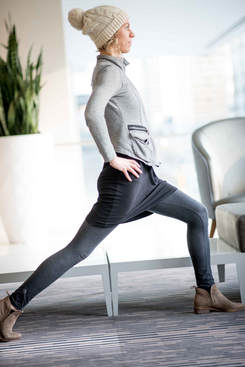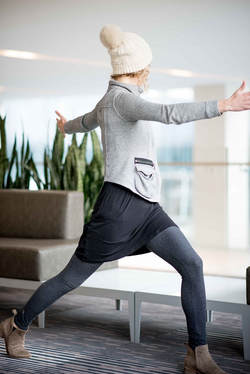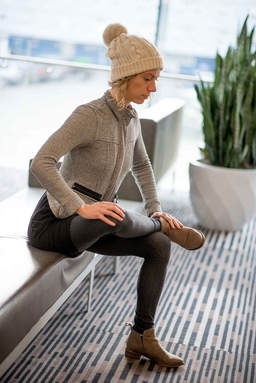|
It’s that time of year again, and unless you’re going south for the next six months, you’ll likely be shoveling a lot of snow. I can’t clear the snow for you, however I can give you a few simple exercises that will help make sure you don’t end up with a nasty back injury after shoveling snow. Lower back injuries are extremely common with snow removal for a number of reasons, but it is avoidable if you prepare yourself beforehand. Trying to lift a shovel full of heavy, wet snow is no easy task, let alone on a slippery surface. Trying to do so without warming up is a recipe for injury. Here are a couple of stretches we recommend doing before you head out. As with any stretch or exercise, if you are experiencing any pain or severe discomfort, stop and ease out.  Shelley demos a lunge to open her right hip flexor Shelley demos a lunge to open her right hip flexor Hip Flexor Stretch Start by stepping one foot in front of the other, getting into a runners lunge. Tuck your pelvis in, making sure you’re not sticking your butt out. Slowly lower your pelvis down, making sure your front knee doesn’t travel past your foot. You should feel a good stretch on the back leg, at the front-side of your hip. Hold for 30-45 seconds. If you’re having trouble balancing, widen your stance or rest the back knee on the ground (use something soft under the knee if there is any pain).  Bring in a twist by turning your torso away from your back leg Bring in a twist by turning your torso away from your back leg Lunge Twist Twists are a nice way to open the back, and you can easily add this into your lunge by turning away from your back leg. You can make this one a little easier by laying down on your back with your arms in a T-shape, and then bringing your knees up and across the body.  A seated glute opener A seated glute opener Glute Stretch The simplest glute stretch is called “Figure 4” because you make a 4-like shape with your legs. You can do this pose standing, seated, or laying on your back. Hold for at least 30-45 seconds on each side. Try leaning forward a little bit to deepen the stretch. By stretching the glutes and hip flexors, we take a lot of stress and tension out of the lower back, allowing the hips to move freely, letting us use our legs properly and waking up our core muscles to support our back when shoveling. It only takes a few minutes and it can save your back from a lengthy and painful recovery.
If you’re having any trouble with these stretches, or if you have any questions, feel free to email me at [email protected] and I’ll be happy to assist.
1 Comment
In Canada, osteopathy isn't as well known as massage therapy or acupuncture. I use a gentle and effective method of unlocking tissue. It's similar to physio therapy where the treatment is done in looser/sport clothing. You can expect:
A treatment usually involves active movement from the client, with gentle stretching and positioning from the therapist. Treatments are pain free and never jarring. Throughout the treatment, I will constantly assess and then reassess to ensure the treatment is effective because the goal is to provide clinical and long-lasting results. What separates a Manual Osteopath from similar professions is that we look at the body as a whole unit, a complete structure, rather than isolating the problem to one joint or muscle. I am excited to offer free 15-minute Manual Osteopathy treatments to my massage clients—you can book on our booking website. I am studying with the National Manual Osteopathic College and I require clinical hours to complete the program, so this practical experience is a huge benefit to me and I’m hoping it will be of benefit to you as well! To learn more about Osteopathy, the short video below does a great job of explaining it: The Brain. It’s our most important and yet least understood organ. We rely on it every day. Not just for keeping us alive, but for simple tasks like making us coffee, dressing ourselves, and driving to work.
In fact, there are very few actions one can take that do not involve the brain in some vital role. Now I know what you’re thinking, “isn’t any organ vital? What about the heart?” The answer is yes—but the brain is unique in a special way. It’s the only organ that we decide how and when we use it. It is the only organ that we have control over. You don’t tell your heart when to beat, or how hard. You don’t ask your liver to speed things up, so you can have that extra glass of wine. So, with the brain being the only organ that we consciously use, that is why brain health is so important. Here are four ways to nurture your noggin:
These simple but imperative methods will help keep your brain working smoothly. I recommend focusing on one or two of these methods to start. Even a little effort can go a long way to helping us have more than just a hat rack sitting on our shoulders. |
AuthorZarko is a Calgary-based Manual Osteopath Archives
May 2021
Categories |

 RSS Feed
RSS Feed